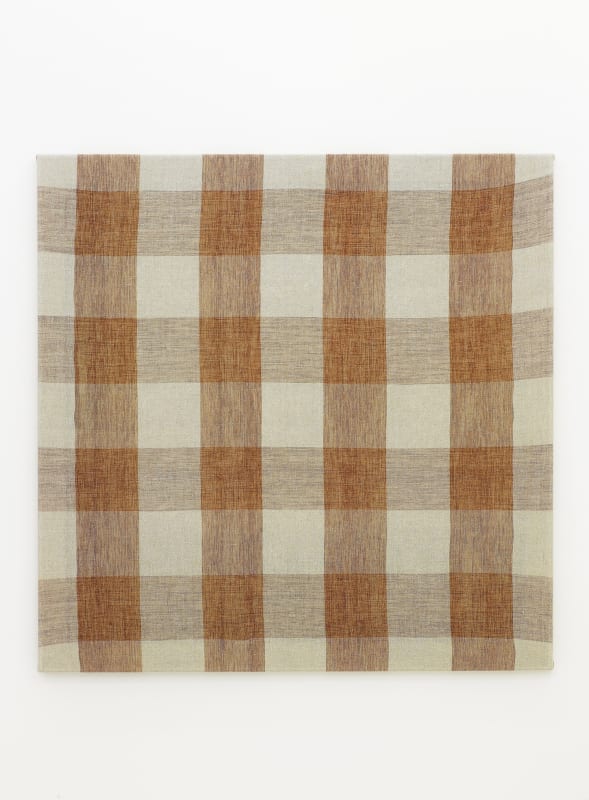HILDUR BJARNADÓTTIR: Background
Although Hildur Bjarnadóttir is acnowledged for work where she deals with textile traditions in a wider context, here, in this exhibition, it is plainly evident how she utilizes widespread influences as a basis for her work in order to create a multifaceted impression. The interconnections between the individual pieces might be difficult to grasp for those that have not followed her progress over the last few years, how do porcelain figurines, chequered paintings and hand-written images relate? Others would know that previously she has not shied away from exhibiting a video of a cowboy twirling his rope alongside a canvas laborously crotcheted out of Belgian linen and mounted on stretcher bars. In the present exhibition Hildur continues in this manner, utilizing influences from her, and our, visual past, relating these with the present situation and discourse in art.
The three figurines are obviously related to the generic porcelain figurines that are so common on mantlepieces of the older generation. They may remind many of their grandmothers – or even great-grandmothers. On closer scrutiny it becomes obvious that the subject matter is in direct relation to that, being portraits of older women, the artist’s three ‘grandmothers’. One is presented to three respectable grand old ladies portrayed in their customary clothing. Hildur is showing us, the audience, three of the esteemed women that have influenced her in the past, and she portrays them in a manner they themselves would have preferred. Porcelain figurines have for a long time been of primary value in the Icelandic home, but in the world of art they are at best considered ‘kitsch’, or “vicarious experience and faked sensations … Kitsch is the epitome of all that is spurious in the life of our times”, to quote the American high modernist art mogul Clement Greenberg who most ardently preached the purity of modern art, emphasising that art should rid itself of all surplus meaning and concetrate on it own, internal, problematics. Hildur Bjarnadóttir, on the other hand, does not differentiate between her ‘mediums’, her vehicle would quite often be defined as ‘kitsch’, but counteracting that is the content, based on personal research into her own reality and the history that reality is based upon, the emotions a far reach from being superfluous or false. Echoing this, she also draws forth the emotional life of the women who influence her and shows respect for the objects they chose for their own surroundings in her work.
The text-images, as well, function so as to excavate memories of the past in order to make them observed in the present. Through them we are able to read, in an elegant handwritten font, snippets from the past lives of Icelandic women. Hildur has extracted these images from conversations with one of her most important peers of the older generation, asking her questions relating to her youth and upbringing. Each image, written in a font made out of the elderly lady’s handwriting, has become a ‘picture’ on the wall. Presented in this way, the stories come near to becoming ‘iconic’, the intricate script, the gilded frame, serves as to make every image not only a unique object, but also provides us with an image of the way things were in the past. We are provided with a glimpse of the past, not just any old past, but the past of a woman that has always had an acute sense of responsibility, and that has, from the early age of six years, proven to be a positive role-model for other women in their battle for human rights. With these modest images Hildur is thus presenting us with glimpses of the main emphasis of the human-rights movement of the previous century.
In the “gingham”-pictures, the third and most dramatic part of the exhibition, Hildur presents us with a continuation of a totally different approach to the past. For a few years now, she has used her textile-based upbringing as source material for her work, doing extensive research on the traditions of textile based art, and on the realationship between textiles and art in general. Textiles have been the major foundation of “high” art ever since the Renaissance – the painter’s canvas being nothing more than a textile-base. In a recent exhibition in the Living Art Museum she exhibited unprimed canvases, handwoven from different types of linen. With these works she can be said to have reached the limits of Minimalism, painting in its essence not being the monochrome, as many have tried to establish in the late century, but textile, being reduced to the ground of painting itself, and full of detail and texture. “Gingham” is the name of the chequered canvases in the present exhibition, a term derived from traditional textile production, gingham being a traditional form of cotton-weave usually used for tablecloths. In these works Hildur uses a traditional textile technique to create works that look like Minimalist pieces, colored lines that cross, and the material is the same aspainters use, linen and acrylic paint. The difference between these works and the work of the painters isn’t, however, superficial, but rests in the basis of each work. To create a similar effect that painters attain, by painting horizontal and vertical lines using transparent paint in order to create interesting hues, Hildur works directly in textiles; she dyes the thread itself with acryllic paint and then proceeds to weave the “painting”. It’s the same material, the same look (almost), but a fundamental difference.

